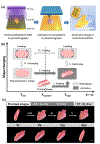Advanced 4D Bioprinting Technologies for Brain Tissue Modeling and Study
- PMID: 32864037
- PMCID: PMC7451241
- DOI: 10.1080/19475411.2019.1631899
Advanced 4D Bioprinting Technologies for Brain Tissue Modeling and Study
Abstract
Although the process by which the cortical tissues of the brain fold has been the subject of considerable study and debate over the past few decades, a single mechanistic description of the phenomenon has yet to be fully accepted. Rather, two competing explanations of cortical folding have arisen in recent years; known as the axonal tension and the differential tangential expansion models. In the present review, these two models are introduced by analyzing the computational, theoretical, materials-based, and cell studies which have yielded them. Then Four-dimensional bioprinting is presented as a powerful technology which can not only be used to test both models of cortical folding de novo, but can also be used to explore the reciprocal effects that folding associated mechanical stresses may have on neural development. Therein, the fabrication of "smart" tissue models which can accurately simulate the in vivo folding process and recapitulate physiologically relevant stresses are introduced. We also provide a general description of both cortical neurobiology as well as the cellular basis of cortical folding. Our discussion also entails an overview of both 3D and 4D bioprinting technologies, as well as a brief commentary on recent advancements in printed central nervous system tissue engineering.
Keywords: 4D Bioprinting; Brain; Cortical folding; Foliation; Gyrification; Organoids; Smart materials.
Conflict of interest statement
Disclosure Statement The authors declare no conflicts of interest.
Figures







Similar articles
-
Recent Advances in 4D Bioprinting.Biotechnol J. 2020 Jan;15(1):e1900086. doi: 10.1002/biot.201900086. Epub 2019 Sep 20. Biotechnol J. 2020. PMID: 31486199 Review.
-
3D bioprinting of tissues and organs for regenerative medicine.Adv Drug Deliv Rev. 2018 Jul;132:296-332. doi: 10.1016/j.addr.2018.07.004. Epub 2018 Jul 7. Adv Drug Deliv Rev. 2018. PMID: 29990578 Review.
-
4D Biofabrication: Materials, Methods, and Applications.Adv Healthc Mater. 2018 Sep;7(17):e1800412. doi: 10.1002/adhm.201800412. Epub 2018 Jul 5. Adv Healthc Mater. 2018. PMID: 29978564 Review.
-
3D bioprinting for drug discovery and development in pharmaceutics.Acta Biomater. 2017 Jul 15;57:26-46. doi: 10.1016/j.actbio.2017.05.025. Epub 2017 May 10. Acta Biomater. 2017. PMID: 28501712 Review.
-
Organ Bioprinting: Are We There Yet?Adv Healthc Mater. 2018 Jan;7(1). doi: 10.1002/adhm.201701018. Epub 2017 Nov 29. Adv Healthc Mater. 2018. PMID: 29193879 Review.
Cited by
-
Integrating biologically inspired nanomaterials and table-top stereolithography for 3D printed biomimetic osteochondral scaffolds.Nanoscale. 2015 Sep 7;7(33):14010-22. doi: 10.1039/c5nr03425f. Epub 2015 Aug 3. Nanoscale. 2015. PMID: 26234364 Free PMC article.
-
Emerging brain organoids: 3D models to decipher, identify and revolutionize brain.Bioact Mater. 2025 Feb 12;47:378-402. doi: 10.1016/j.bioactmat.2025.01.025. eCollection 2025 May. Bioact Mater. 2025. PMID: 40026825 Free PMC article. Review.
-
Advances in current in vitro models on neurodegenerative diseases.Front Bioeng Biotechnol. 2023 Nov 6;11:1260397. doi: 10.3389/fbioe.2023.1260397. eCollection 2023. Front Bioeng Biotechnol. 2023. PMID: 38026882 Free PMC article. Review.
-
Preparation of Smart Materials by Additive Manufacturing Technologies: A Review.Materials (Basel). 2021 Oct 27;14(21):6442. doi: 10.3390/ma14216442. Materials (Basel). 2021. PMID: 34771968 Free PMC article. Review.
-
3D Printing for Neural Repair: Bridging the Gap in Regenerative Medicine.Adv Mater. 2025 Sep;37(36):e07590. doi: 10.1002/adma.202507590. Epub 2025 Jul 30. Adv Mater. 2025. PMID: 40736088 Free PMC article.
References
-
- Armstrong E, et al. (1995). “The Ontogeny of Human Gyrification.” Cerebral Cortex 5(1): 56–63. - PubMed
-
- Sekiguchi M, et al. (1991). “Abnormalities of foliation and neuronal position in the cerebellum of NZB/BINJ mouse.” Developmental Brain Research 64(1): 189–195. - PubMed
-
- Wallace Gregory L.; Robustelli Briana; Dankner Nathan; Kenworthy Lauren; Giedd Jay N.; Martin Alex (2013-June-01). “Increased gyrification, but comparable surface area in adolescents with autism spectrum disorders”. Brain. 136 (6): 1956–1967. doi:10.1093/brain/awt106. ISSN 0006–8950. PMC 3673467 Freely accessible. PMID 23715094. - DOI - PMC - PubMed
-
- Harris JM, et al. (2007). “Increased Prefrontal Gyrification in a Large High-Risk Cohort Characterizes Those Who Develop Schizophrenia and Reflects Abnormal Prefrontal Development.” Biological Psychiatry 62(7): 722–729. - PubMed
Grants and funding
LinkOut - more resources
Full Text Sources
Miscellaneous
